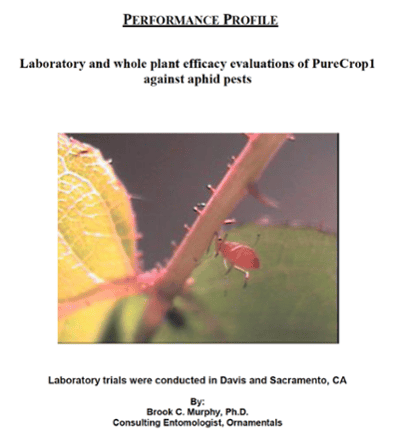Aphids use their long slender mouthparts to pierce stems, leaves, and other tender plant parts and suck out fluids. There are approximately 4,000 different species of aphids. While it may be hard to distinguish between the different species, the management of most aphids is similar. These soft, pear-shaped insects may be green, brown, red, or black. Some species appear white or gray due to the secretion of a waxy or wooly substance over their body. Almost every plant has one or more aphid species that feed on it.
Study: Common Aphids
Test Date: 8/1/18
Location: Davis & Sacramento, CA
This study examined the performance of PureCrop1 against four common aphids; the melon, rose, green peach, and bean variety aphids. Four replicates of aphids were tested for each of the four treatments tested (16 replicates per experiment). Each replicate generally consisted of at least 20 to 50 aphids on a host leaf (see attached data in report). Chrysanthemum leaves were used for the melon aphid trials, rose leaves for the rose and green peach aphid trials, and ‘orange jasmine’ leaves for the black bean aphid.
Treatment Rates & Methods
Once with three different Dilution rates. Materials were mixed to dilution in 1.0-liter bottles. Either 1.66, 3.33, or 6.66 ml of PureCrop1 were poured into bottles partially filled with water and filled to volume to obtain either 600:1, 300:1, and 150:1 dilutions.
“Overall, the results of these evaluations provide encouraging evidence that PureCrop1 could be developed into an effective, reliable and easy-to-use commercial insecticide against aphid pests.” - Brook C. Murphy, Ph.D

The graph illustrates the dose-mortality relationship of PureCrop1 treatments on four aphid species (melon, rose, green peach, and bean aphids) 36 hours after application.
Study Conclusions
Under the test conditions of the laboratory trials, it can be concluded that PureCrop1 has proven itself to be an effective control agent at 600:1 dilutions or greater.
Furthermore, the degree of aphid control was consistent across replicates, experiments, and aphid species. These evaluations suggest PureCrop1 could operate as a reliable and effective aphicide.
The results of the laboratory trials also suggested that the optimal concentration for PureCrop1 for aphid control could go lower (>300: 1) without sacrificing efficacy. This could further reduce the per-acre cost of the product while minimizing any threat from phytotoxicity.
The whole plant trials clearly demonstrated that PureCrop1 could be an effective pest control tool for aphids on plants. These evaluations demonstrated that under more realistic and variable outdoor conditions, a single application of PureCrop1 was sufficient to eliminate virtually all aphids from plants in 24 to 36 hours. This control was achieved despite any residual mortality or repellency of the product.
Overall, the results of these evaluations provide encouraging evidence that PureCrop1 could be developed into an effective, reliable, and easy-to-use commercial insecticide against aphid pests.
Additionally, Results of residual activity and repellency observations revealed no significant residual mortality or repellency to aphids at the rates tested. Of 48 aphid adults released, 89.6% (43 out of 48) settled on terminal shoots or buds and began to reproduce on the untreated rose plants. For the treated roses, 81.4% (35 out of 43) settled and reproduced within 10 days. In both treatments, adults migrated to preferred feeding sites (terminal shoots of major rose canes), no reluctance on the part of aphids was noted to settle down in previously treated areas.
Aphid study white paper
View the entire white paper on the study
Suggested Dilution Rates
PureCrop1 is not a "one-and-done" type of spray typical to conventional chemical treatments. Much of PureCrop1's chemistry occurs on the microscopic level, making it difficult to observe in real-time. However, you should see a noticeable difference in your plant with consistent coverage after your first few sprays.
Conventional Agriculture
In the conventional agriculture space, we suggest using a 0.75% dilution rate of PureCrop every 7-12 days as a preventative. If you are experiencing an infestation, increase the dilution rate to 1.5% and also increase frequency.
Hydroponics & Greenhouse
For hydroponics, greenhouse, and garden growers, we suggest a 1-oz dilution rate every 7-10 days as a preventative. Increase the dilution rate to 2-oz of PureCrop1 per gallon of filtered water, spraying every 2-3 days until the infestation is gone.


